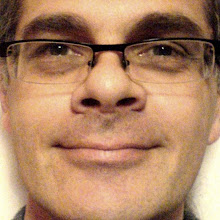Now, the lunchtime concert, Pianopianopiano. A piano concert, then, with a couple of woodwind sequenzae slipped in as well. The first of these, for alto flute by John Roy Garrod, was given an absolutely stunning performance by Jo Ashcroft. Really. She played the piece not just with her breath, or her lips, but with her entire body; every single gesture in the piece was practically danced; stamping her feet, looking at the audience, crouching down, standing erect, to the point where I actually started to wonder whether the composer had written it into the score. And, an entirely succesful piece of writing as well, if it can produce a performance like this.
On the subject of sequenzas, sooner or later someone is going to notice that there wasn't one for piano. What's that piece, is it by Christian Wolff, where the pianist is asked to push the piano against a wall, then keep pushing? That's kind of the way many composers feel about the piano in these days, that it is a nineteenth century obstacle, a piece of furniture perhaps better replaced by something nice and new from Ikea.
So we decided not to have a piano sequenza. However, that doesn't stop many of us from wanting to write for and with the piano. Jekabs Nimanis To Observe. To Listen. was... an ok piece, starting out with chords, then some almost but not quite minimalist single note material, then some almost but not quite C20th stride, finishing up with some inside the piano material, very carefully executed by Flavia Casari. (Back in the land of the perfunctory nods again; even Jekabs gave one. Mind you, composers always give the perfunctory nod. 'Cept me, natch.)
Dusty Bits by Justin Fung was a great piano piece, concentrating on but not restricted to the top bit of the piano, the 'dusty bit' of the title. A really great piece this, kind of a toccata or a moto perpetuo, with an opening somewhat reminiscent of Ligeti's Volumina for harpsichord, but by no means restricted to that language; well structured, with a perfectly poised ending. Very, very good piano writing here, absolutely nailed by Junlan Zhao.
Anna Shucksmith's sequenza for oboe came next, performed by Arlene Cochrane. The piece seemed to mainly alternated between intense, long, low slung notes alternating with pointy material, with some deliberately overblown notes placed along the way. A very convincing performance, perhaps not quite as overtly physical as Jo on the alto flute, but completely engaged with the piece in any case. Good.
I was rather unkind to Alexei Khevelev's piece of two days ago, but today's set of ten preludes Russian Roulette I found myself somewhat better disposed to. An entirely conventional idea expressed in entirely conventional pianistic terms, mostly conveying an appropriate atmosphere of threat. A little over the top in places, but maybe that's just the way Alexei likes to play.
The big piece of the afternoon was Kevan O'Reilly's Nobody has the answer, for two synthesisers and two amplified pianos. Yes, amplifed pianos, tick, and a really rather tasteless square wave patch on the synths, tick. The piece was long, and had continual layers of rhythm, so in that sense one had to say it seemed be conciously using the minimalist keyboard idiom, but in a freely composed way, without any sense of 'process'. The harmony was much muddier than the bland or poised (to taste) approach of Reich or Glass, kind of pop aesthetic I-don't-care-what-the-notes-are-I-like-them harmony, sometimes very dense and obscure, sometimes quite attractive, sometimes really rather ugly. My overall impression of this piece - I should really have checked with Kevan before writing this, I mean it as a compliment - was of somebody straining over a really big, long, dump, and finally suceeding.
And... the force is strong in the piano department these days, under the leadership of Aaron Shorr; in particular a very disciplined approach to Kevan's really rather difficult piece, unconducted, by Junlan Zhao, Chenfei Zhu, Jessica Leong, and Ayako Kanazawa.
Thursday, 30 April 2009
Thursday lunchtime
Posted by J. Simon van der Walt at 15:31
Subscribe to:
Post Comments (Atom)

1 comments:
The piano pushing piece is an early piece by La Monte Young. Can't remember which one. Might be 'Piece for David Tudor'
Post a Comment